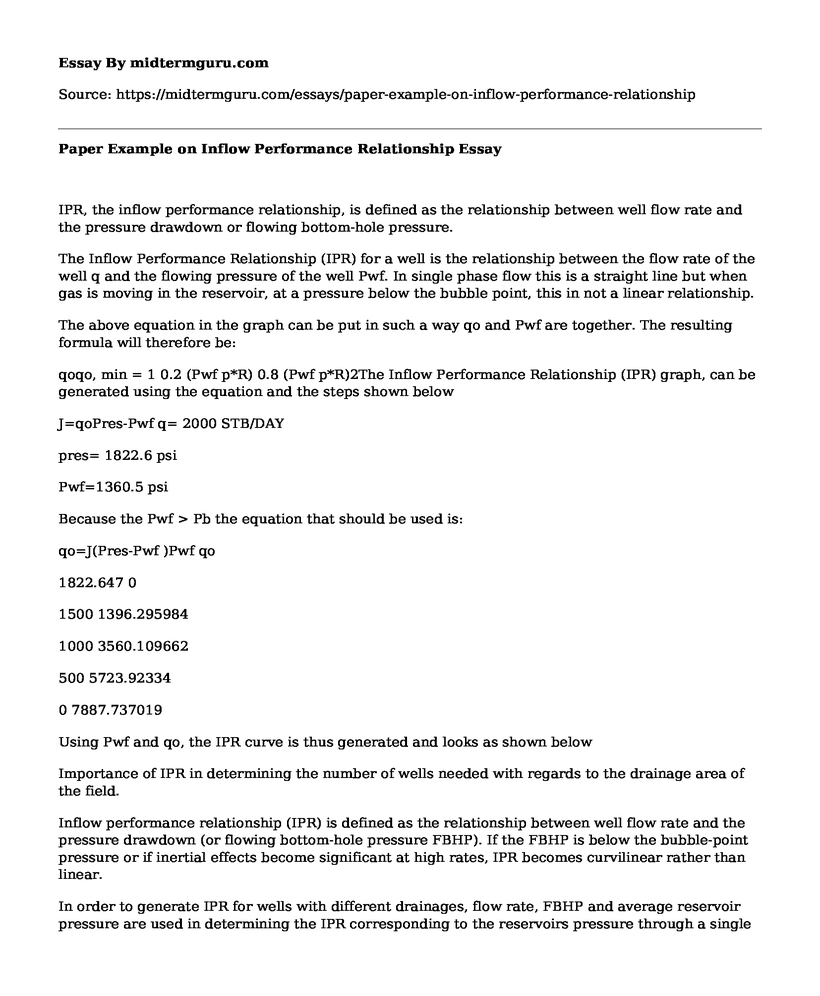IPR, the inflow performance relationship, is defined as the relationship between well flow rate and the pressure drawdown or flowing bottom-hole pressure.
The Inflow Performance Relationship (IPR) for a well is the relationship between the flow rate of the well q and the flowing pressure of the well Pwf. In single phase flow this is a straight line but when gas is moving in the reservoir, at a pressure below the bubble point, this in not a linear relationship.
The above equation in the graph can be put in such a way qo and Pwf are together. The resulting formula will therefore be:
qoqo, min = 1 0.2 (Pwf p*R) 0.8 (Pwf p*R)2The Inflow Performance Relationship (IPR) graph, can be generated using the equation and the steps shown below
J=qoPres-Pwf q= 2000 STB/DAY
pres= 1822.6 psi
Pwf=1360.5 psi
Because the Pwf > Pb the equation that should be used is:
qo=J(Pres-Pwf )Pwf qo
1822.647 0
1500 1396.295984
1000 3560.109662
500 5723.92334
0 7887.737019
Using Pwf and qo, the IPR curve is thus generated and looks as shown below
Importance of IPR in determining the number of wells needed with regards to the drainage area of the field.
Inflow performance relationship (IPR) is defined as the relationship between well flow rate and the pressure drawdown (or flowing bottom-hole pressure FBHP). If the FBHP is below the bubble-point pressure or if inertial effects become significant at high rates, IPR becomes curvilinear rather than linear.
In order to generate IPR for wells with different drainages, flow rate, FBHP and average reservoir pressure are used in determining the IPR corresponding to the reservoirs pressure through a single stabilized test (single-point test). Chengs Model applies to the cases where the well penetrates the producing interval at an angle. The angle ranges from zero (vertical well) to 90 degrees (horizontal well). The model is a semi-analytical one, wherein the coefficients of the polynomial equations vary with the inclination angle. For example, the correlations for the 30 and 75 degrees scenarios are respectively:
Majority of the pressure drop caused by production is near the wellbore. This is confirmed by the radial flow equation. In this situation even if the average reservoir pressure is above the bubble point, the area around the wellbore is not, which causes the gas to come out of solution in this area causing the relative permeability (which is based on fluid saturation) of the liquids to change. As the pwf is lower for a greater flow rate the greater this effect has on the well which causes the IPR Curve to bend down.
[qo/qomax]300 = 0.9959 0.1254[pwf/pr] 0.8682[pwf/pr]2[qo/qomax]750 = 0.9915 + 0.1002[pwf/pr] 1.0829[pwf/pr]2
Where;qo = oil flow rate, bbl/dayqomax = oil flow rate at FBHP = 0, bbl/daypwf = FBHP = flowing bottom hole pressure, psipr = reservoir pressure, psith = slant or deviation angle, degrees
In generating the IPRs for horizontal wells, their IPR method is based on estimates of reservoir/well architecture and fluid properties, rather than stabilized flow tests. The central task is to evaluate the maximum oil flow rate (absolute open flow potential).
Calculation of the number of wells
Step 1: The Ae equation, which is the drainage area of the field is going to be used
Ae=0.234qBohCtmParameters of the drainage area of the field
Slope of the trend(m) 4.3276
Production rate (q) 2000bbl/day
Formation Thickness (h) 212ft
Formation Volume factor (Bo) 1.116
Rack compressibility factor (Ct) 0.00000746
Porosity () 0.259
Step 2: Calculation of the Ae and it should be in ft^2
Step 3: Put the asthmatic of a drainage area of horizontal well (2000ft)
Step 4: Calculation for the number of wells
A1= LW = 2000 ft 2(0.5 )
0.5 is the radius in ft
A2 = p 0.5 2/ 2
A3= LW = (rL/c ) (2r ) = ((0.5 )(2000) / 70 )(2(0.5) = 14.28 ft^2
At= 2000+0.39269+14.2858 = 2014.67839 ft^2
#wells= Drainage Area (Ae)Drainage of each wells =292261.702014.67839= 146.24 = 146 wells
Cite this page
Paper Example on Inflow Performance Relationship. (2021, Jun 29). Retrieved from https://midtermguru.com/essays/paper-example-on-inflow-performance-relationship
If you are the original author of this essay and no longer wish to have it published on the midtermguru.com website, please click below to request its removal:
- The Relationship Between Financial Reporting and Audit Quality - Essay Sample
- AT&T Inc Company Financial Analysis Paper Example
- Target Acquisition Firms and Financial Performance of BCB Berhad and IWCITY Berhad - Paper Example
- Managing a Recession with a Low Interest Rate - Essay Sample
- 200+ Years of Financial Services: BMO Harris Bank - Research Paper
- Trump's Tax Reforms: Promises Fulfilled After 3 Decades - Essay Sample
- LIHTC: Tax Credit Program for Low-Income Affordable Housing - Essay Sample







